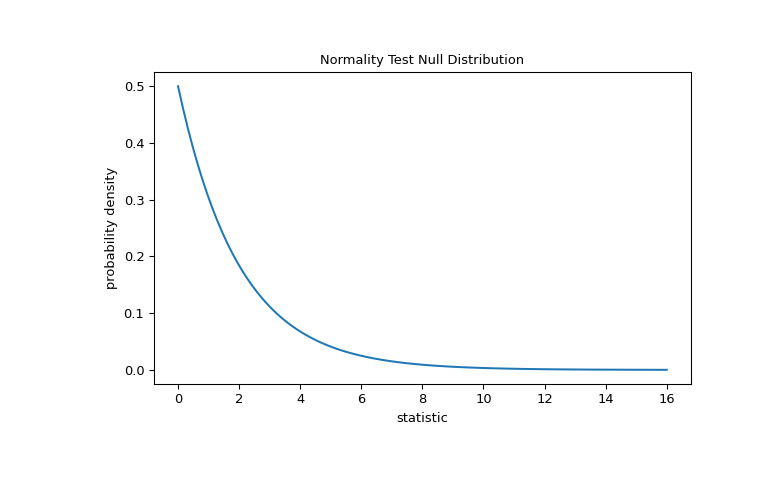本文簡要介紹 python 語言中 scipy.stats.normaltest 的用法。
用法:
scipy.stats.normaltest(a, axis=0, nan_policy='propagate')#檢驗樣本是否不同於正態分布。
此函數檢驗樣本來自正態分布的原假設。它基於 D'Agostino 和 Pearson 的 [1]、[2] 檢驗,該檢驗結合了偏斜和峰態以產生對正態性的綜合檢驗。
- a: array_like
包含要測試的樣本的數組。
- axis: int 或無,可選
計算測試的軸。默認值為 0。如果沒有,則計算整個數組 a。
- nan_policy: {‘propagate’, ‘raise’, ‘omit’},可選
定義當輸入包含 nan 時如何處理。以下選項可用(默認為‘propagate’):
‘propagate’: returns nan
‘raise’: throws an error
‘omit’: performs the calculations ignoring nan values
- statistic: 浮點數或數組
s^2 + k^2,其中s是skewtest返回的 z-score ,k是kurtosistest返回的 z-score 。- pvalue: 浮點數或數組
假設檢驗的 2 邊卡方概率。
參數 ::
返回 ::
參考:
[1] (1,2)D'Agostino, R. B. (1971),“中等和大樣本量的正態性綜合檢驗”,Biometrika,58,341-348
[2] (1,2)D'Agostino, R. 和 Pearson, E. S. (1973),“偏離常態的測試”,Biometrika, 60, 613-622
[3]夏皮羅,S.S. 和威爾克,M.B. (1965)。正態性方差檢驗分析(完整樣本)。生物計量學,52(3/4),591-611。
[4]B. Phipson 和 G. K. Smyth。 “排列 P 值不應該為零:隨機抽取排列時計算精確的 P 值。”遺傳學和分子生物學中的統計應用 9.1 (2010)。
[5]帕納吉奧塔科斯,D.B. (2008)。 p 值在生物醫學研究中的值。開放心血管醫學雜誌,2, 97。
例子:
假設我們希望從測量中推斷醫學研究中成年男性的體重是否不呈正態分布[3]。重量(磅)記錄在下麵的數組
x中。>>> import numpy as np >>> x = np.array([148, 154, 158, 160, 161, 162, 166, 170, 182, 195, 236])[1] 和 [2] 的正態性檢驗首先根據樣本偏度和峰度計算統計量。
>>> from scipy import stats >>> res = stats.normaltest(x) >>> res.statistic 13.034263121192582(該測試警告我們的樣本觀測值太少,無法執行測試。我們將在示例末尾返回這一點。)因為正態分布具有零偏度和零(“excess” 或 “Fisher”)峰度,對於從正態分布中抽取的樣本,該統計值往往較低。
該檢驗是通過將統計量的觀測值與零分布進行比較來執行的:零分布是在權重從正態分布中得出的零假設下得出的統計值的分布。對於此正態性檢驗,非常大的樣本的零分布是具有兩個自由度的卡方分布。
>>> import matplotlib.pyplot as plt >>> dist = stats.chi2(df=2) >>> stat_vals = np.linspace(0, 16, 100) >>> pdf = dist.pdf(stat_vals) >>> fig, ax = plt.subplots(figsize=(8, 5)) >>> def plot(ax): # we'll re-use this ... ax.plot(stat_vals, pdf) ... ax.set_title("Normality Test Null Distribution") ... ax.set_xlabel("statistic") ... ax.set_ylabel("probability density") >>> plot(ax) >>> plt.show()
比較通過 p 值進行量化:零分布中大於或等於統計觀測值的值的比例。
>>> fig, ax = plt.subplots(figsize=(8, 5)) >>> plot(ax) >>> pvalue = dist.sf(res.statistic) >>> annotation = (f'p-value={pvalue:.6f}\n(shaded area)') >>> props = dict(facecolor='black', width=1, headwidth=5, headlength=8) >>> _ = ax.annotate(annotation, (13.5, 5e-4), (14, 5e-3), arrowprops=props) >>> i = stat_vals >= res.statistic # index more extreme statistic values >>> ax.fill_between(stat_vals[i], y1=0, y2=pdf[i]) >>> ax.set_xlim(8, 16) >>> ax.set_ylim(0, 0.01) >>> plt.show()
>>> res.pvalue 0.0014779023013100172如果 p 值為 “small” - 也就是說,如果從正態分布總體中采樣數據產生統計數據的極值的概率較低 - 這可以作為反對零假設的證據另一種選擇:權重不是從正態分布中得出的。注意:
反之則不成立;也就是說,檢驗不用於為原假設提供證據。
將被視為 “small” 的值的閾值是在分析數據之前應做出的選擇 [4],同時考慮誤報(錯誤地拒絕零假設)和漏報(未能拒絕假設)的風險。錯誤的原假設)。
請注意,卡方分布提供了零分布的漸近近似;它僅對於具有許多觀測值的樣本是準確的。這就是我們在示例開始時收到警告的原因;我們的樣本很小。在這種情況下,
scipy.stats.monte_carlo_test可以提供更準確的(盡管是隨機的)精確 p 值的近似值。>>> def statistic(x, axis): ... # Get only the `normaltest` statistic; ignore approximate p-value ... return stats.normaltest(x, axis=axis).statistic >>> res = stats.monte_carlo_test(x, stats.norm.rvs, statistic, ... alternative='greater') >>> fig, ax = plt.subplots(figsize=(8, 5)) >>> plot(ax) >>> ax.hist(res.null_distribution, np.linspace(0, 25, 50), ... density=True) >>> ax.legend(['aymptotic approximation (many observations)', ... 'Monte Carlo approximation (11 observations)']) >>> ax.set_xlim(0, 14) >>> plt.show()
>>> res.pvalue 0.0082 # may vary此外,盡管具有隨機性,以這種方式計算的 p 值可用於精確控製原假設的錯誤拒絕率 [5]。
相關用法
- Python SciPy stats.norminvgauss用法及代碼示例
- Python SciPy stats.norm用法及代碼示例
- Python SciPy stats.nbinom用法及代碼示例
- Python SciPy stats.nchypergeom_wallenius用法及代碼示例
- Python SciPy stats.nakagami用法及代碼示例
- Python SciPy stats.nct用法及代碼示例
- Python SciPy stats.ncf用法及代碼示例
- Python SciPy stats.ncx2用法及代碼示例
- Python SciPy stats.nchypergeom_fisher用法及代碼示例
- Python SciPy stats.nhypergeom用法及代碼示例
- Python SciPy stats.anderson用法及代碼示例
- Python SciPy stats.iqr用法及代碼示例
- Python SciPy stats.genpareto用法及代碼示例
- Python SciPy stats.skewnorm用法及代碼示例
- Python SciPy stats.cosine用法及代碼示例
- Python SciPy stats.directional_stats用法及代碼示例
- Python SciPy stats.invwishart用法及代碼示例
- Python SciPy stats.bartlett用法及代碼示例
- Python SciPy stats.levy_stable用法及代碼示例
- Python SciPy stats.page_trend_test用法及代碼示例
- Python SciPy stats.itemfreq用法及代碼示例
- Python SciPy stats.exponpow用法及代碼示例
- Python SciPy stats.gumbel_l用法及代碼示例
- Python SciPy stats.chisquare用法及代碼示例
- Python SciPy stats.semicircular用法及代碼示例
注:本文由純淨天空篩選整理自scipy.org大神的英文原創作品 scipy.stats.normaltest。非經特殊聲明,原始代碼版權歸原作者所有,本譯文未經允許或授權,請勿轉載或複製。
